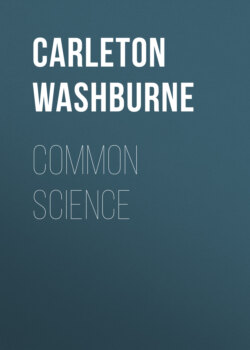Читать книгу Common Science - Carleton Washburne - Страница 49
На сайте Литреса книга снята с продажи.
Fig. 33. With this arrangement the pail travels more slowly than the hand. Will it seem heavier or lighter than with the arrangement shown in Figure 32?
ОглавлениеTable of Contents
Next fasten one end of the string to the nail. Set the pail on the floor. Pass the string through the handle of the pail and up over the spool (Fig. 33). Pull down on the loose end of the string. Is the pail easier to lift in this way or in the way you first tried? As you pull down with your hand, notice whether your hand moves farther than the pail, not so far as the pail, or the same distance. Is the greater amount of motion in your hand or in the pail? Then where would you expect the greater amount of force?
The whole idea of the lever can be summed up like this: one end of the contrivance moves more than the other. But energy cannot be lost; so to make up for this extra motion at one end more force is always exerted at the other.
This rule is true for all kinds of levers, blocks and tackles or pulley systems, automobile and bicycle gears, belt systems, cog systems, derricks, crowbars, and every kind of machine. In most machines you either put in more force than you get out and gain motion, or you put in more motion than you get out and gain force. In the following examples of the lever see if you can tell whether you are applying more force and obtaining more motion, or whether you are putting in more motion and obtaining more force:
Cracking nuts with a nut cracker.
Beating eggs with a Dover egg beater.
Going up a hill in an automobile on low gear.
Speeding on high gear.
Cutting cloth with the points of shears.
Cutting near the angle of the shears.
Turning a door knob.
Picking up sugar with sugar tongs.
Pinching your finger in the crack of a door on the hinge side.
Application 16. Suppose you wanted to lift a heavy frying pan off the stove. You have a cloth to keep it from burning your hand. Would it be easier to lift it by the end of the handle or by the part of the handle nearest the pan?
Application 17. A boy was going to wheel his little sister in a wheelbarrow. She wanted to sit in the middle of the wheelbarrow; her brother thought she should sit as near the handles as possible so that she would be nearer his hands. Another boy thought she should sit as near the wheel as possible. Who was right?
Application 18. James McDougal lived in a hilly place. He was going to buy a bicycle. "I want one that will take the hills easily," he said. The dealer showed him two bicycles. On one the back wheel went around three times while the pedals went around once; on the other the back wheel went around four and a half times while the pedals went around once. Which bicycle should James have chosen? If he had wanted the bicycle for racing, which should he have chosen?
Application 19. A wagon stuck in the mud. The driver got out and tried to help the horse by grasping the spokes and turning the wheel. Should he have grasped the spokes near the hub, near the rim, or in the middle?
